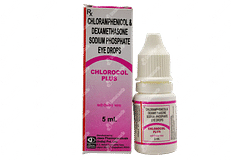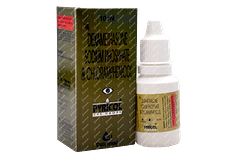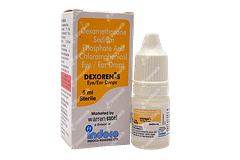Chloramphenicol + Dexamethasone + Phenylmercuric Nitrate
Uses of Chloramphenicol + Dexamethasone + Phenylmercuric Nitrate
Chloramphenicol + Dexamethasone + Phenylmercuric Nitrate is principally used to manage various eye infections and inflammatory conditions. It belongs to the group of medicines that combine an antibiotic and a corticosteroid.
Additionally, it is beneficial in managing bacterial conjunctivitis, blepharitis (inflammation of the eyelids), keratitis (inflammation of the cornea), and iritis (inflammation of the iris).
Side effects of Chloramphenicol + Dexamethasone + Phenylmercuric Nitrate
Temporary burning or stinging sensation
Blurred vision
Itching or redness of eyes or eyelids
Increased intraocular pressure
Delayed wound healing
How Chloramphenicol + Dexamethasone + Phenylmercuric Nitrate works
Chloramphenicol + Dexamethasone + Phenylmercuric Nitrate is a combination antibiotic and corticosteroid used for ophthalmic conditions.
Chloramphenicol is a broad-spectrum antibiotic. It works by binding to the bacterial ribosome, where it stops the production of essential proteins required by bacteria to carry out vital functions. This inhibits bacterial growth and replication, thereby managing the bacterial infection.
Dexamethasone is a corticosteroid, a type of medicine that reduces inflammation. It works by binding to glucocorticoid receptors, which leads to a decrease in the production of inflammatory substances in the body. This results in reduced swelling, redness, and pain associated with eye inflammation.
Phenylmercuric Nitrate serves as a preservative in this combination. It helps prevent the growth of bacteria and other microbes that could contaminate the medicine, ensuring it remains safe and effective for use.
Certified content
Written By

BAMS, FMC, MD Resident
Reviewed By

BDS, MDS
Expert Advice
Dosage Forms Available
Chloramphenicol + Dexamethasone + Phenylmercuric Nitrate is available for ophthalmic use in the form of eye drops and eye ointment.
The eye drops typically contain an aqueous base, suitable for instillation directly into the eyes. The ointment is based in sterile petrolatum, intended for application to the eyelids or directly to the eye surface.
Age and Dose Restrictions
This combination is meant for use by adults and children.
Contraindications
Chloramphenicol + Dexamethasone + Phenylmercuric Nitrate is contraindicated in patients with known hypersensitivity to any of its components.
It is also contraindicated in cases of untreated fungal, viral, or mycobacterial ocular infections and those with a history of angle-closure glaucoma or known steroid-induced intraocular pressure elevation.
Other Medications to Avoid
Chloramphenicol + Dexamethasone + Phenylmercuric Nitrate can interact with anticoagulants (such as warfarin), cancer medications (like imatinib), salicylates (like aspirin), antitubercular medications (like isoniazid), immunosuppressants (like cyclosporine), oral contraceptives (oestrogen-progesterone), and NSAIDs (like ibuprofen).
Overdose and Missed Dose
In case you happen to put a few extra drops of this combination in your eye, do not panic. Rinse your eyes with clean water at room temperature. If any symptoms persist or worsen, inform your doctor.
If you miss a dose of this medicine, apply it as soon as possible, unless it is almost time for your next dose. Do not double the dose to make up for the missed one.
Management of Side Effects
Most side effects are temporary and generally harmless and resolve when discontinuing this combination. However, if you experience any severe side effects or worsening of any of the symptoms, please consult your doctor.
To manage temporary burning or stinging that might occur immediately after application, close your eyes and rest briefly.
Use in Driving and Operating Machinery
This combination may temporarily blur your vision or cause other visual disturbances, which could affect your ability to drive or operate machinery safely. Avoid these activities if you do not have clear vision after using this combination.
Use in Pregnancy and Lactation
The safety of Chloramphenicol + Dexamethasone + Phenylmercuric Nitrate during pregnancy and lactation has not been established. It is advised to consult your doctor before using this combination if you are pregnant or breastfeeding.
Caution in Other Conditions
Patients with severe liver impairment need to exercise caution when using Chloramphenicol + Dexamethasone + Phenylmercuric Nitrate owing to potential toxicity.
Special Dietary and Lifestyle Recommendations
Ensure adequate hydration to help maintain eye moisture.
Practice good hygiene, especially around your eyes; wash hands thoroughly before applying eye medication.
Wear sunglasses when outdoors to protect your eyes from UV rays which can aggravate eye conditions.
Frequently asked questions
Is Chloramphenicol + Dexamethasone + Phenylmercuric Nitrate a steroid?
Yes, one of the components in this combination, Dexamethasone, is a type of corticosteroid. The other two components, Chloramphenicol and Phenylmercuric Nitrate, are an antibiotic and a preservative, respectively.
Can Chloramphenicol + Dexamethasone + Phenylmercuric Nitrate be used for any type of eye infection?
This combination is specifically used for bacterial eye infections and inflammation. It should not be used for untreated fungal, viral, or mycobacterial ocular infections.
Can Chloramphenicol + Dexamethasone + Phenylmercuric Nitrate affect mood or hormones?
Generally, this combination's direct effect on mood or hormones is not established owing to its primary use in treating eye conditions. However, any concerns about potential side effects should be discussed with your doctor.
Can Chloramphenicol + Dexamethasone + Phenylmercuric Nitrate cause blood disorders?
In rare cases, Chloramphenicol may cause severe blood disorders like aplastic anaemia or leukaemia. Any unusual symptoms should be reported to the doctor immediately.
Can I use makeup while using Chloramphenicol + Dexamethasone + Phenylmercuric Nitrate for eye infections?
It is advisable to avoid makeup and contact lenses during the treatment period to prevent further irritation or bacterial contamination.
Is there a specific time when Chloramphenicol + Dexamethasone + Phenylmercuric Nitrate should be applied?
The timing for using this combination can vary based on your doctor's advice and the specific condition being managed. Always follow your doctor's instructions.
Can Chloramphenicol + Dexamethasone + Phenylmercuric Nitrate be used for long-term treatment?
This combination is not generally prescribed for long-term use, unless directed by a doctor. Prolonged therapy may lead to adverse effects.
Chloramphenicol + Dexamethasone + Phenylmercuric Nitrate in other salts
List of Medicines for Chloramphenicol + Dexamethasone + Phenylmercuric Nitrate




Company
About UsHealth ArticleHealth StoriesHealth LibraryDiseases & Health ConditionsAyurvedaUnderstanding Generic MedicinesAll MedicinesAll BrandsNeed HelpFAQSecuritySubscribe
Registered Office Address
Grievance Officer
Download Truemeds
Contact Us
Our customer representative team is available 7 days a week from 9 am - 9 pm.
v4.10.3
2025 - Truemeds | All rights reserved. Our content is for informational purposes only. See additional information.
Our Payment Partners










